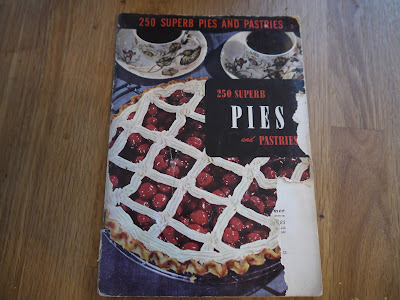When we last were together, we were working on our first ever cherry pie. We had just rolled our crust into the piepan and were about to start on our pie filling. There were so many pies to choose from in the 250 Superb Pies and Pastries cookbook, but I picked good ol' cherry pie--no food coloring, no mincemeat, no tapioca--just plain cherry.
Cherry Pie
2 cups canned sweetened red cherries
2 tablespoons cornstarch
3 tablespoons sugar
1/8 teaspoon salt
1 cup cherry juice
1 tablespoon butter
1 plain pastry
1) Drain cherries, saving juice. Mix cornstarch, sugar, and salt.
2) Add juice gradually and cook slowly until smooth and thickened.
This part took a little time, but after about five minutes or so, the juice started to thicken and slide even slower off the spatula. I was ready for cherries!
3) Add butter and cherries. Cool.
4) Line piepan with pastry, pour in filling, and cover with top crust.
So simple! Because I had already made my bottom crust, all I needed to do was roll out the top crust, pour in the filling, and cover the pie for baking. My dough chilled while I cooked the pie filling, so I kept things rolling (pie pun!) by flouring my surface and working out the second half of the dough.
Okay, I just want to pause for a minute and say that as a recovering perfectionist, pie-making is really hard. There are about a million variables that can go wrong, and I'm in control of essentially none of them. That is a very hard truth to accept. At one point, I had to roll up my dough and start over because it just wasn't sticking together. I am pretty sure I did everything the same as with the bottom crust, but it just wasn't working for me. Whatever. Pie pity party over.
Once the top crust was rolled out, I poured the cherry filling into the piepan. It was thick and gooey, and the right amount for the pie crust. I was ready to cover my pie.
At this point, the Plain Pastry recipe we worked from last time advised "to dampen the edges of the lower crust with cold water and cover with remaining dough, which has been rolled out and slashed in several places to allow steam to escape while baking."
So that's what I did. I'm nothing if not a rule-follower.
I placed the top dough ever-so-gingerly on top of the pie, then crimped the edges with a fork to help hold it all together. Because my dough wasn't perfectly round (deep breaths), I also needed to trim the edges with a knife.
5) Bake in very hot oven (450 degrees F) for 15 minutes; reduce to moderate (350 degrees F) and bake about 25 minutes longer.
This was a moment of truth for me. My first ever pie, heading into the oven. No turning back. What's done is done. After an agonizing 40 minutes, it was time to retrieve my freshly-baked pie.
Look how beautiful! The crust is golden brown and the pie is in tact. I was over the moon!
But how would it taste? We had to wait a while for our first bite, as this pie was already claimed for our church's Sunday potluck and we couldn't cut into it just yet. By the time we made it through the serving line, several pieces were already gone, but we managed to cut a little piece for testing. We took the slice back to the table, and it was incredible!
The crust was flaky, the filling held together, and the flavors were great. It wasn't too sweet or too tart--it was just right! At least, we thought so, anyway. The real test would come a few days later when I made the pie again for our family's Thanksgiving dinner. It was just as unpredictable, time-consuming, and stressful as the first time I made it, but the pie looked decent enough. I just hoped it would taste good, too!
I knew our relatives would be polite and eat the pie and say nice things, but I was seeking one vote of approval, in particular. Back in August when I started this blog, my dad had specifically requested I make him a cherry pie, so I was most anxious for his reaction. It was the only dessert he ate that night, and I'm pleased to say it got the official Head Nod of Approval. (And a pat on the back, and a hug, and a lot of other really nice words. He's my dad, and he loves me. And he loves Sheila. And pie.)
And with that, I'm officially a pie-maker! Only 249 more kinds to make. I think I know how I'll be spending the winter...



















































